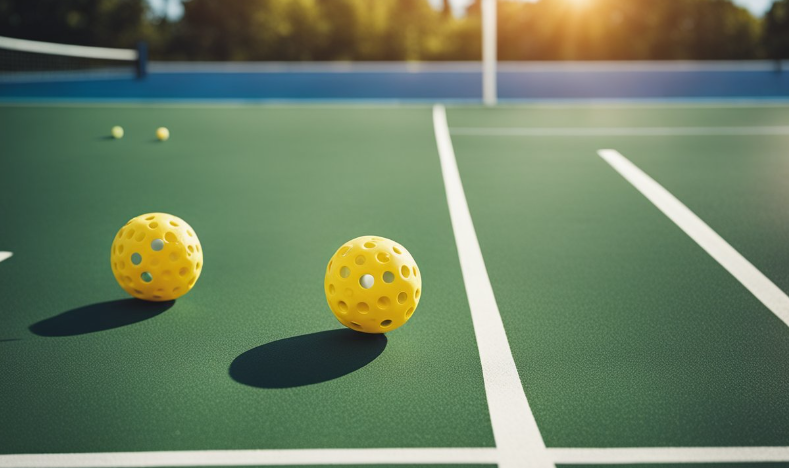The Tactical Neuroscience of the Dink and Drop Shot in Pickleball
How Subtlety Becomes Strategy in a Sport of Synaptic Warfare
Overview: Not Just Shots—Neurological Disruptors
In the age of AI-enhanced athletics and precision coaching, the dink and drop shot in pickleball represent more than finesse—they are cognitive disruptors engineered to destabilize rhythm, alter court geometry, and introduce chaos into predictable sequences. To treat these shots as “gentle” is to misunderstand their systems-level impact.
Not sure what the dink really is? Start with this what is a dink shot in pickleball breakdown before diving into its mind-game mechanics.
Both shots operate like low-impact signals in a neural feedback loop, challenging traditional cause-effect gameplay and giving rise to what we might call: Cognitive Asymmetry in Sport.
Dink Shot: The Socratic Question of the Court
Metaphor: The dink is the Socratic question—not an attack, but a probe that forces your opponent to reveal their weakness.
In philosophy, Socrates didn’t confront; he questioned. Similarly, the dink initiates open-loop exchanges—unpredictable sequences where the first to lose precision, loses the point. Rather than end the rally, the dink opens it.
Want to sharpen your dink execution? Learn how to dink in pickleball with court-level techniques.
Dink = Temporal Disruption
It breaks tempo. A rally meant to progress becomes suspended in strategic purgatory—neither player attacking, both probing. This is rare in modern sports, where speed is usually rewarded.
Dinks shine when paired with smart court sense and tight paddle control. Curious how gear plays into it? Explore what is pickleball paddle control for a deeper look at touch vs. torque.
Drop Shot: The Tactical Misdirection Engine
Metaphor: The drop shot is the Trojan horse—appearing soft and harmless, but delivered from deep to break defensive structures.
A good drop shot isn’t just hard to reach—it reverses court polarity. It forces a backcourt player to break their base posture and sprint forward while recalibrating stroke preparation. This creates a biomechanical lag, where movement outruns timing.
Looking for a competitive edge? This breakdown of pickleball strategy for beginners sets the groundwork for drop-shot dominance.
Emerging Perspective: Smart Shots in the Age of AI
As pickleball evolves, so do the tools we use to train. While AI platforms like SwingVision have revolutionized tennis by rewarding depth-to-soft transitions, similar tech is on the horizon for pickleball. Expect smart training apps—designed around paddle angles, NVZ shot control, and tempo disruption—to soon quantify the neural chaos created by dink and drop shot sequences.
But you don’t have to wait for the future to train like it’s already here.
You can already simulate these brain-bending shot patterns with pickleball ball machines. Yes, they’re usually associated with drives and repetition—but when set up properly, they become powerful tools for building soft touch dominance.
Machine-Mode Drill: “The Soft Chaos Protocol”
Here’s how to turn your machine into a cognitive weapon:
- Set Frequency to Randomized Delay
This simulates the tempo breaks created by dink/drop exchanges. - Adjust Speed to Low-to-Mid Velocity
You want floating balls that force footwork adjustments, not power drives. - Use Mixed Spin or Slight Underspin
This mimics the unpredictable bounce of a real dink return. - Target the Front Half of the Court
Practice your third shot drops, short resets, and off-balance dinks in the NVZ zone. - Finish with a Lob Recovery Drill
After 5 dinks, have the machine fire a deep lob. Practice the reset—just like you would mid-asymmetry chain.
Bonus Challenge: Try shadowing your opponent’s predicted reaction after each shot. You’re not just drilling mechanics—you’re building future-state empathy.
New Model: “Cognitive Load Shots”
Let’s define a new category:
Cognitive Load Shots (CLS) are those that introduce complexity disproportionate to their physical effort.
| Shot Type | Physical Intensity | Cognitive Disruption | Net Effect |
|---|---|---|---|
| Smash | High | Low | Dominance |
| Drive | Medium | Medium | Tempo Pressure |
| Dink/Drop | Low | High | Cognitive Asymmetry |
Dink and drop shots shine not because of power—but because of the mental overclocking they induce in the opponent.
Still working on shot placement and precision? Here’s how to improve accuracy in pickleball without needing a power game.
Prediction Model: The Quantum Court
In future training systems, pickleball rallies will be analyzed as probabilistic flows, not deterministic moves.
Imagine a quantum-state rally: each shot collapses a range of possible opponent reactions into a single outcome. The dink and drop increase the “entropic uncertainty” of what comes next—forcing your opponent to constantly collapse decision branches.
Future analytics platforms like Biome.ai or NeuroPickle (speculative) could track:
- Eye microfixation delay on dink shot descent
- Neurofeedback loops on delayed decision rebounds
- Pupil dilation during shot-fake recognition
Sound wild? The NFL already uses this tech for quarterbacks. And if you want to practice deceptive shot drills on your own, check out this guide to practicing pickleball against a wall.
Cross-Sport Synthesis: Fencing, Chess, and Go
| Sport | Analog to Dink | Analog to Drop Shot |
|---|---|---|
| Fencing | Feint-blade retreat | Step-lunge double fake |
| Chess | Tempo-zugzwang | Positional bait |
| Go | Slow play on tengen | Sacrificial territory bid |
The strategy behind the dink and drop is evident across multiple disciplines where subtlety and asymmetry matter more than brute force.
New Tactical Framework: The “Asymmetry Chain”
Any combination of dinks, drop shots, and delayed lobs creates an asymmetry chain—a pattern of strokes designed to unravel opponent symmetry (stance, rhythm, posture, cognition).
3-Step Chain Example:
→ Dink short to NVZ right
→ Drop shot midline from backcourt
→ Lob left
Curious how gear can support that style of play? Explore the best pickleball paddles for control—because touch starts with the tool in your hand.
Tactical Ethics: The Empathy Edge
Truly elite players don’t win by overpowering—they win by feeling what their opponent dreads most.
The dink and drop are empathy-powered weapons. They don’t succeed unless you can feel timing disruptions in your opponent’s movements. Much like a jazz musician feels the pause before the beat, advanced pickleball players use rhythmic voids—silences between power plays.
Looking for gear that matches that feel? These top-rated pickleball paddles blend responsiveness with finesse.
Final Take: Control is the New Power
In this era of high-velocity play and high-tech gear, it’s the player who can control the chaos that walks off the court victorious. Dinks and drop shots aren’t passive—they’re proactive systems designed to unravel rhythm, posture, and decision flow.
So, master the soft shots. Train like you’re programming a prediction model. And remember:
Every soft shot is a question. Every panic return is the answer.
Now go send some neurons into disarray.
Need help building your pickleball training around strategy—not just power? The Ace Pickleball Pro homepage has you covered with expert guides, paddle reviews, and court-tested insights.

